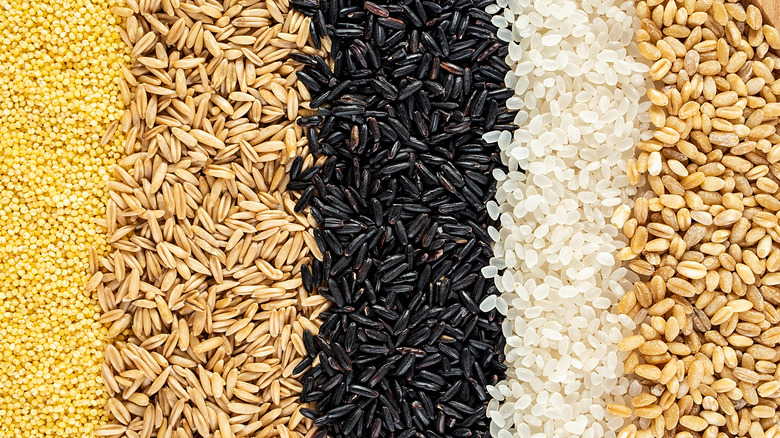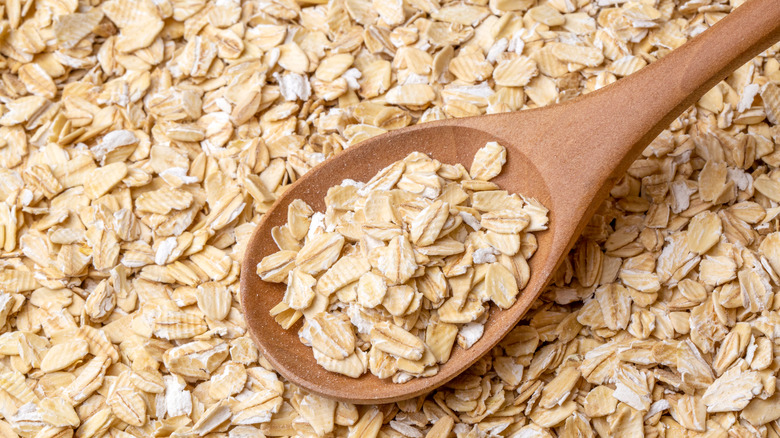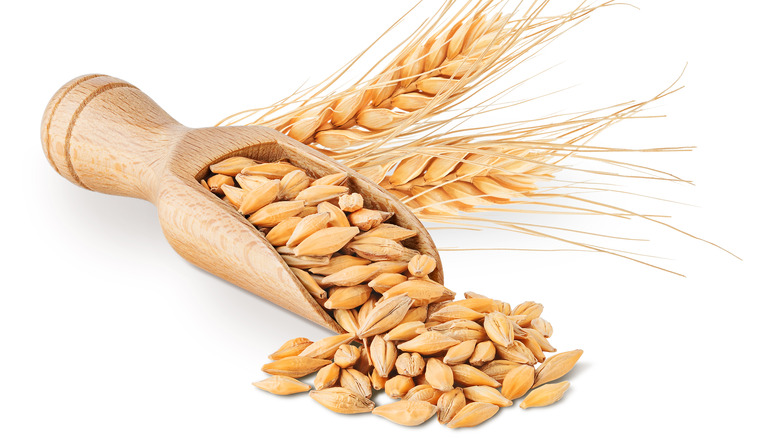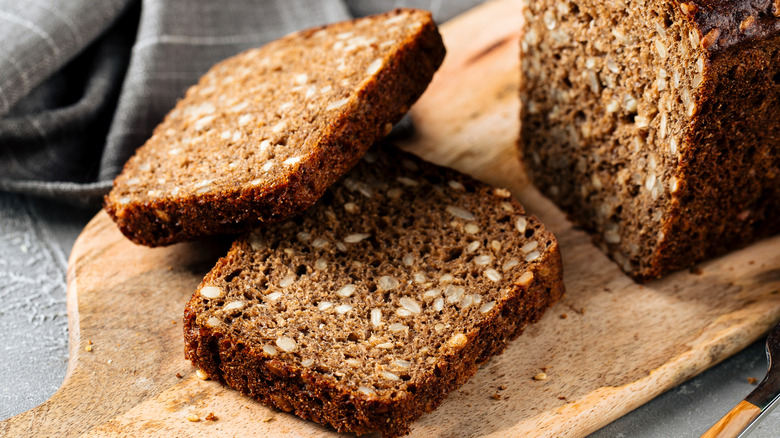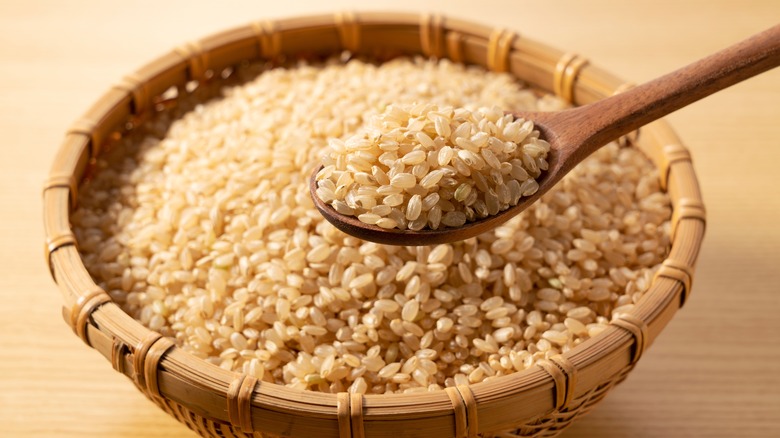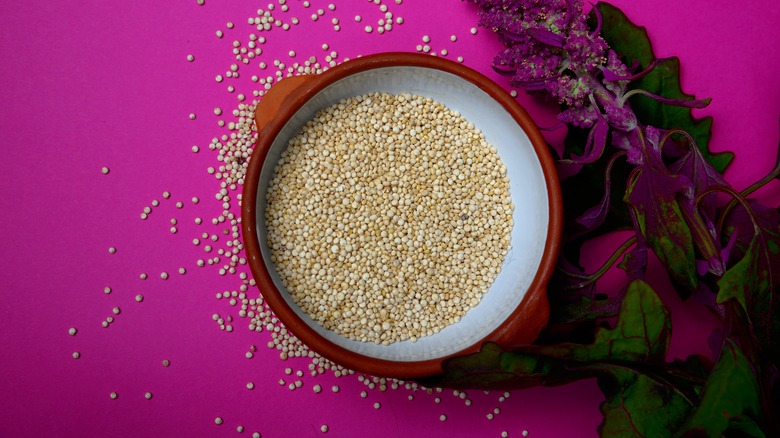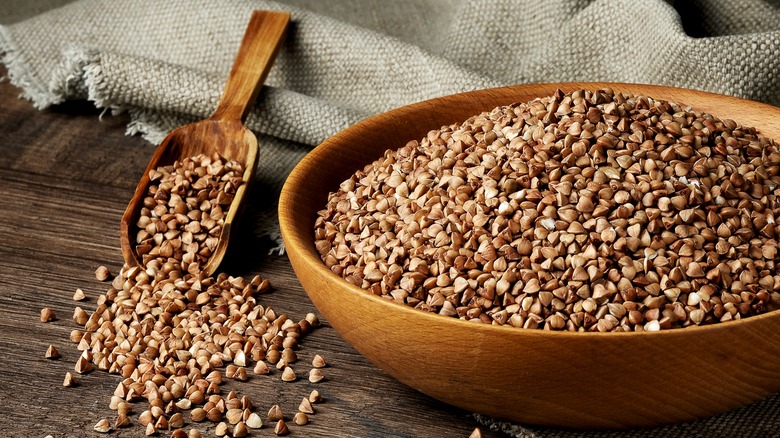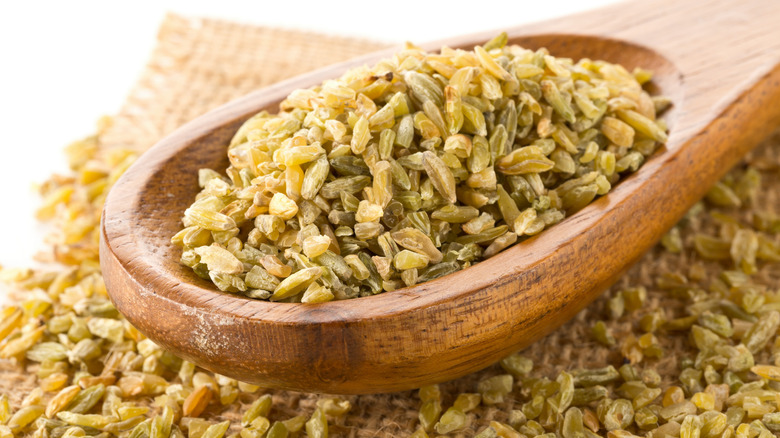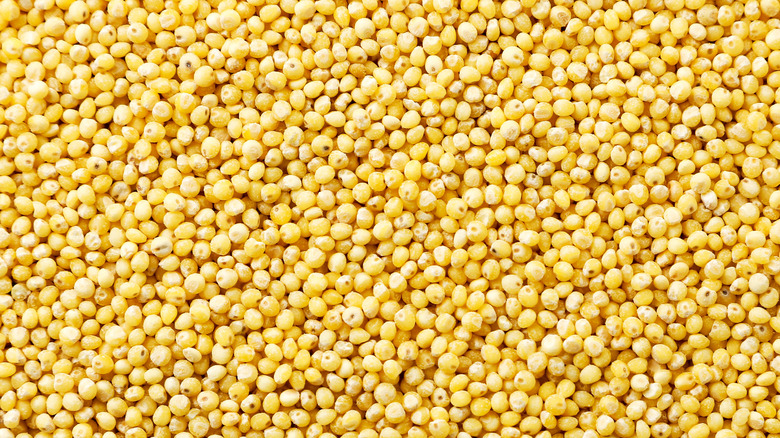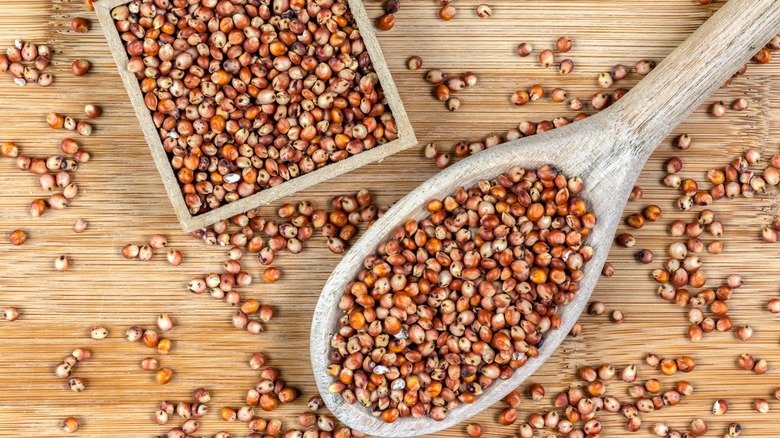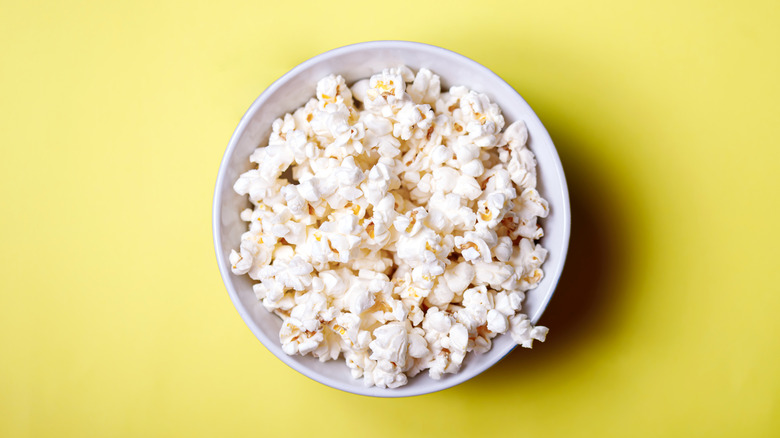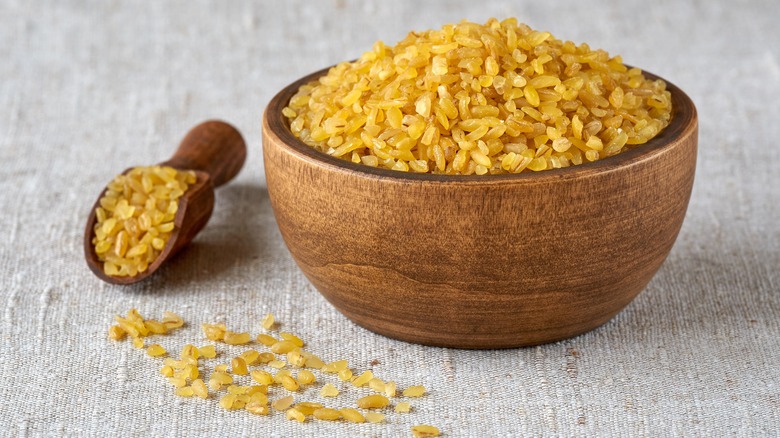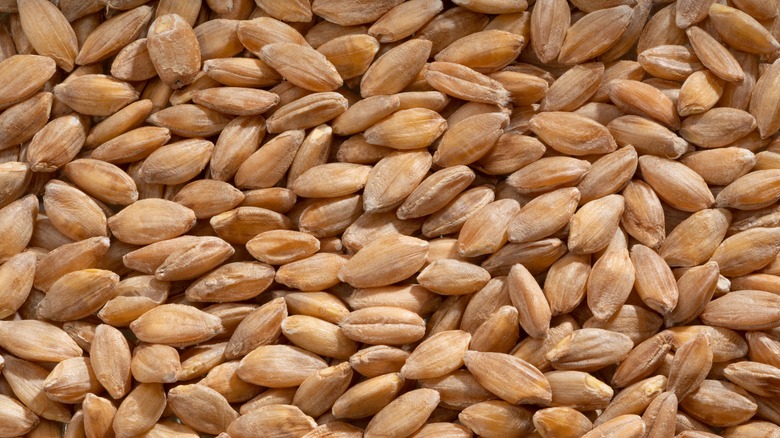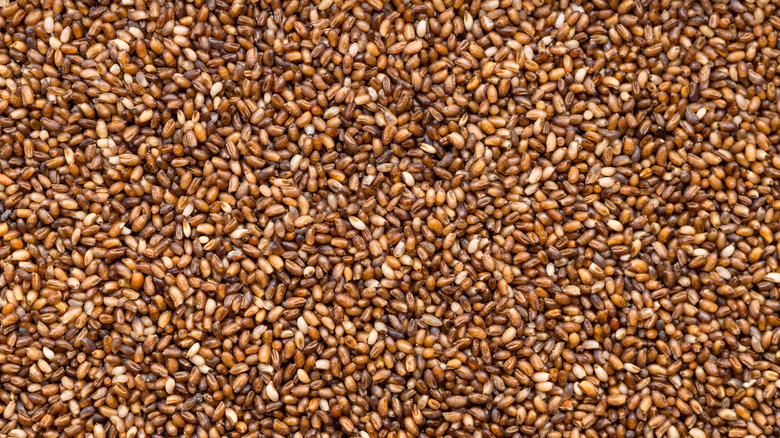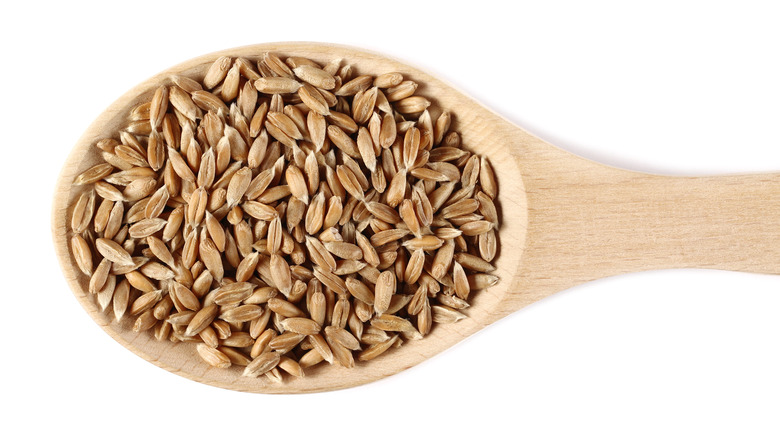14 Whole Grains You Should Be Eating
On the surface, it seems easy to tell what is and isn't a whole grain. As the Mayo Clinic explains, whole grains are seeds that come from different types of grass. However, as The Spruce Eats points out, some non-grass seeds known as pseudocereals are also classified as whole grains because they're consumed the same way as grains.
Okay, now that we cleared that up, let's talk about the differences between whole grains and other types of grains. As the Mayo Clinic explains, grains have three main parts: the bran, the germ, and the endosperm. However, sometimes manufacturers remove the germ and the bran from grains in part to give them a longer shelf life. These altered grains are called refined grains and are lower in nutrients than whole grains, which as their name suggests, still have all three of their parts. In addition, some grains are enriched, meaning nutrients are added back in via the manufacturing process. Also, a manufacturer might add nutrients that don't naturally occur in grains. This is known as fortifying.
The bottom line is just because a food is made from, for example, wheat, doesn't mean you're getting a whole grain product. And even though different seeds classified as whole grains can have similar nutritional benefits, that doesn't mean they're all interchangeable especially if you have certain medical concerns. So, learning more about some of their benefits and drawbacks can help you make the best choices for your dietary needs.
Oats
Think back to the first time you heard the story of "Goldilocks and the Three Bears." Depending on what part of the world you live in, you might have wondered what this food called porridge is and why this little girl would risk the wrath of bears no less to eat it. Well, as Healthline explains, porridge can refer to oatmeal, and whole oat foods can be very good for one's health.
According to the U.S. Department of Agriculture (USDA), 100 grams of flour made from whole grain oats is packed with nutrients like potassium and phosphorus (372 milligrams), magnesium (125 milligrams), and calcium (43 milligrams). It also contains iron, selenium, and molybdenum. Now, probably you're familiar with iron and selenium, but as the National Institute of Health points out, molybdenum is also important for your good health in part because it assists your body in breaking down harmful substances.
Additionally, whole oats are a good source of fiber (10.5 grams), per USDA. In particular, they are loaded with a soluble fiber called beta-glucan (via Healthline). And as a study in the International Journal of Molecular Sciences found, beta-glucan might help lower cholesterol, which can be beneficial for one's heart. Plus, whole oats are gluten-free, making them a good option for someone with problems digesting gluten. However, if you want to try the most whole version of the whole oats (a.k.a. oat groats), they do take longer to cook than, for example, steel-cut oats.
Barley
If you're looking for a food that's a great source of fiber, then barley might be the perfect addition to your meal plan. As Good Housekeeping explains, there are 6 grams of fiber packed into a single cup of pearled barley, which isn't even the whole grain version of barley. However, fiber is just one healthy benefit of this barley in general.
Before we go any further, we need to discuss phytochemicals, which is the umbrella term for a large variety of plant chemicals (via Good Housekeeping). And while we're still learning about them, they have the potential to be very beneficial to one's health. According to the Journal of Food and Drug Analysis, research shows how barley has such phytochemicals as phenolic acids, which might lower the chances of someone developing a chronic disease. Barley also contains flavonoids, a phytochemical that might be beneficial for patients with coronary heart diseases or cancer. In addition, barley has phytochemicals called tocopherols and tocotrienols. These chemicals might decrease the odds of having a stroke, as well as developing cardiovascular diseases and cancer.
Besides phytochemicals, barley is also packed with phosphorus, manganese, and selenium (via Good Housekeeping). It also contains protein, iron, and vitamins B6 and niacin. But despite all of barley's potential health pluses, it's not gluten free, so if you have celiac disease or are on a low-gluten diet, you might want to consider a different whole grain on this list to meet your health needs.
Rye
If you look into the history of rye, you'll find it's a sneaky plant. As Dr. Steven Gundry, the author of "The Longevity Paradox: How to Die Young at a Ripe Old Age," told Well+Good, rye began life as a weed fighting for its life. Now, imagine you're a farmer who grows wheat. The last thing you would want is weeds growing in your wheat field. But according to Dr. Gundry, rye "evolved to mimic wheat to avoid detection." And it's a good thing it did, because this little grain can be a healthy addition to one's diet.
So, let's discuss arguably one of the most popular rye products on the market: rye bread. One of the biggest pluses of this kind of bread is it's packed with fiber, which as registered dietician and certified dietitian nutritionist Shira Sussi told Well+Good has several potential health benefits. "Its high-fiber content makes it a heart-healthy grain good for lowering blood pressure and cholesterol," Sussi said, adding, "Its slow transit time [in your digestive system] and ability to be only partially digested is beneficial for gut health." Additionally, whole grain rye bread contains antioxidants, as well as nutrients like phosphorus, magnesium, and potassium.
Although rye, and, in particular, rye bread, can be a healthy choice, it does contain gluten. However, Sussi and Dr. Gundry said that rye sourdough is a lower gluten option. Nevertheless, if gluten is an issue for you, check with your health care professional before trying sourdough rye.
Brown rice
As WebMD notes, humans grow more than 40,000 varieties of rice. And while that might sound overwhelming, keep in mind that when you buy brown rice, you're buying whole grain rice.
Of course, we can't talk about the possible health benefits of brown rice without discussing the glycemic index (GI). According to WebMD, when a food has a low GI, it doesn't cause spikes in your blood sugar. And if you guessed that brown rice has a low GI, you're not only right, but there's even data suggesting that three servings of brown rice daily might help lower your chances of becoming a type 2 diabetic. Furthermore, brown rice is loaded with magnesium and fiber, both of which can be beneficial for one's heart. But wait, there's more. This whole grain also contains other nutrients like thiamine, manganese, selenium, pyridoxine, and phosphorus.
Yes, brown rice has nutrients, but as Health points out, it also contains arsenic. However, Conrad Choiniere, director of the Office of Analytics and Outreach at the FDA's Center for Food Safety and Applied Nutrition, told The Washington Post that based on current scientific findings regarding the arsenic in rice, the FDA doesn't recommend adults eat less rice, adding, "Consumers can eat rice as part of a well-balanced diet." So, portion control, moderation, and incorporating other whole food carbs into your diet is very important. What's more, a study in the Science of The Total Environment found that boiling brown rice could help reduce its arsenic content.
Quinoa
Okay, so let's clear up the million dollar question: How do you pronounce quinoa? Well, one official pronunciation is the first syllable is said the same way as the word "keen" and the last syllable is "wah." But learning how to say "keen-wah" isn't the only important fact when it comes to this whole grain.
According to Harvard, quinoa has all nine essential amino acids. And, yes, these little molecules have earned the title "essential" since they form proteins, per MedlinePlus. So, when you eat quinoa, you're taking in proteins that have these amino acids. After your body breaks down the protein, it can use the amino acids to help a person grow and help damaged tissues in their body heal. Amino acids can also give a person energy and aid with digestion. And since we can't create these amino acids on our own, it's important that we take them in through, for example, foods like quinoa.
Besides amino acids, quinoa also contains fiber, as well as nutrients like vitamin B1, magnesium, manganese, folate, and phosphorus (via Harvard). And it's gluten free, making it a good choice for patients with celiac disease. However, there are many varieties of quinoa (more than 120 to date), so you do want to pick what's going to fit your personal preferences and taste. Just remember, yellow and white quinoa have a milder flavor than black and red quinoa.
Buckwheat
Since "wheat" is in its name, it's not a surprise that buckwheat is a type of whole grain. But as Medical News Today points out, Buckwheat is actually a pseudocereal, which means that although it doesn't come from grass, it's still consumed like a grain. And like other whole grains, buckwheat can bring a great deal of healthy benefits to the table.
Of course, you can't talk about buckwheat's potential health benefits without discussing a hallmark of grains: complex carbohydrates, per Medical News Today. As MedlinePlus explains, complex carbs are changed by the body into blood sugar, which gives the body's cells' energy. And, yes, simple carbohydrates can also do this, but foods containing complex carbs are also packed with nutrients and fiber. Case in point, buckwheat is a source of several B vitamins, including folate, riboflavin, thiamin, and niacin. It also has vitamin K and protein, as well as fiber, which might aid in digestion in part because it can support the intestines. In addition, complex carbs can also help with blood sugar management.
Although buckwheat can be a good choice for someone looking to incorporate more whole grains into their diet, Medical News Today points out that some individuals might have an allergic reaction to buckwheat. Now, this isn't a commonly reported food allergy in the United States, but possible signs of it include hives and swelling in the mouth.
Freekeh
As Prevention explains, freekeh is basically a type of wheat that we harvest and consume while it's still in the early stages of its growth when it's green. Now, you might be thinking harvesting a food before its fully matured doesn't sound like a good idea. After all, certain fruits would taste far less sweet if we picked them before they fully ripened. But in the case of freekeh, it's actually the secret behind its nutritional benefits.
As registered dietitian nutritionist Frances Largeman-Roth told Prevention, "Because it's harvested when it's young, the grain retains more nutrition—providing more protein, fiber, and minerals than in wheat that's harvested mature." These minerals include iron, calcium, and magnesium. And as Anna Taylor, a registered dietitian at the Cleveland Clinic, told Consumer Reports, magnesium is important to your nervous system, bones, and muscles. It also helps your body maintain healthy blood sugar levels, heart rate, and blood pressure. Plus, freekeh is also higher in protein and fiber than two other whole grains on this list: brown rice and quinoa.
Although freekeh has some strong health pluses, it (like other varieties of wheat) does have gluten. And remember, a person can have gluten sensitivity even if they don't have celiac disease. But with that said, if gluten isn't an issue, you can boil freekeh just like rice and serve it as a whole grain, nutrient-packed side dish.
Millet
If you have a bird feeder, you might buy wild bird food that includes millet. This is because this grain has been a popular choice for wild birds, as well as domesticated animals like livestock, per Medical News Today. But don't let any of that discourage you from giving this whole grain a try.
According to the U.S. Department of Agriculture (USDA), 100 grams of cooked millet is packed with 62 milligrams of potassium, 44 milligrams of magnesium, and 100 milligrams of phosphorus. It also has manganese and copper, as well as protein and fiber. And as Medical News today explains, fiber can be a helpful addition to one's diet if they are experiencing irregular bowel movements. Furthermore, millet can also help keep one's gut healthy since it has prebiotics. As the Mayo Clinic notes, our guts have microscopic organisms, including bacteria. Prebiotics help to feed these microorganisms, which not only keeps them healthy but also encourages the growth of new microorganisms.
Unlike some of the other whole grains on this list, millet doesn't have gluten, which can be a plus for individuals with celiac disease, per Medical News Today. However, it does have antinutrients, which are compounds that make it harder for the body to take in nutrients. So, you might need to do a little research to find the best type of millet for your nutritional needs.
Sorghum
No, the "Sorghum Belt" isn't some crazy new fashion fad. It refers to an area of the United States where farmers plant millions of acres of sorghum, via Verywell Fit. And it's not surprising since this whole grain has been a popular choice for foods like syrups, as well as various drinks that contain alcohol. But just because it's associated with some not-so-healthy foods doesn't mean it isn't packed with nutrients.
According to the U.S. Department of Agriculture USDA, a cup of sorghum grains contains 317 milligrams of magnesium and 6.45 milligrams of iron. But wait, there's more. That same cup of sorghum has 20.4 grams of protein, as well as 25 milligrams of calcium, 555 milligrams of phosphorus, and 697 milligrams of potassium. Additionally, it has other minerals like selenium, manganese, and zinc, as well as B vitamins like pantothenic acid, thiamin, riboflavin, and niacin.
Of course, everyone's dietary needs are different, and a concern that comes up with whole grains is whether or not they contain gluten. Fortunately, if you have celiac disease or are sensitive to gluten, sorghum can be a good alternative to other whole grains since it doesn't have gluten. But even if you're not on a gluten-free diet, you might want to give this whole grain a try for its nutritional benefits.
Popcorn
Let's face it, corn has a little bit of an identity crisis. Think about the last time you ordered mixed vegetables at a restaurant. Chances are corn was part of that mix even though it's technically a grain. But one place that corn gets the spotlight all to itself is as that staple of every movie theater — popcorn. And, yes, this whole grain can be a nutritious snack choice — sometimes.
As the American Heart Association points out, air-popped popcorn that isn't loaded down with other ingredients is a good snack option. After all, it's high in fiber, and the right amount of fiber in your diet might help with weight management, as well as might make you less likely to develop certain health problems like diabetes, heart disease, and even certain cancers. Speaking of cancers, a type of antioxidant found in popcorn might also reduce the risk of developing some types of cancers. These antioxidants are also possibly good for your digestive and circulatory systems.
While popcorn has its pluses, you do want to be careful when you order popcorn at the movies. As Maya Vadiveloo, an assistant professor in the department of nutrition and food sciences at the University of Rhode Island, told the American Heart Association, movie popcorn is typically loaded with salt and higher in calories. "Sodium is one of the leading risk factors for hypertension and stroke in general."
Bulgur wheat
Sometimes the manufacturing process makes a big difference when it comes to the final food product. Take bulgur wheat for example. It starts out as regular wheat, as WebMD explains, and then goes through a process before it's considered bulgur wheat. Specifically, it's boiled, dried, and ground up, creating a versatile whole grain suitable for a variety of dishes. But despite this process, the bulgur wheat still has all the parts of the wheat kernel and so can potentially provide a number of health benefits.
Like other whole grains on this list, bulgur wheat contains vitamins like niacin, folate and vitamin B6, per WebMD. It's also a good source of minerals like magnesium, iron, and manganese. Plus, a half a cup of it boiled not only has 3 grams of protein but also doesn't have cholesterol or fat. But where bulgur wheat really shines is it's a great source of fiber, which means incorporating bulgur wheat into one's diet could help with blood sugar and weight management, as well as can support your digestive system. Fiber might also make you less likely to experience health problems like cancer and coronary artery disease.
Now to be fair, there is some debate if it's the fiber or some other aspect of bulgur wheat that helps with blood sugar management. Nevertheless, there is a general consensus at this time that this whole grain is good for keeping one's blood sugar from spiking.
Einkorn
Plant hybrids aren't unusual in this day and age. But that doesn't mean there aren't species that remain unchanged. For example, every type of wheat in the world today came from the original wheat: einkorn, per Well+Good. And multiple millennia later, einkorn is still around and still packed with nutritious benefits.
Now, if you were to compare a kernel of einkorn to some other types of wheat, it would be notably smaller. But, as they say, good things come in small packages, and einkorn is no exception. Despite its little size, it has more protein than not only the other whole grains on this list but also any other grain you can think of, including other types of wheat, as revealed by Food. In addition, it's lower in starch, which along with some of its other properties makes it less likely than some other wheats to spike one's blood sugar.
Now, of course, being a wheat, einkorn does contain gluten, but there's an interesting twist here. As Well+Good explains, a person who is sensitive to gluten might have an easier time digesting einkorn than other types of wheat. According to Frontiers in Nutrition, this is because the gluten in einkorn is different structurally from the gluten in other wheats. However, being sensitive to gluten isn't the same thing as having celiac disease, so someone with celiac disease should still avoid this whole grain.
Teff
Okay, we need to clear up some confusion over this next whole grain. As The Healthy points out, teff is at times spelled with only one f. And, yes, farmers in the U.S. have grown teff only for horse feed, but that practice is changing. Also, the Ethiopian government did at one time ban the exportation of teff, but this was because of the grain's growing popularity and concerns that continuing to export it would lead to a teff shortage.
Now that we've cleared all that up, let's talk about the nutritional pluses of this tiny whole grain. As registered dietitian nutritionist Danielle Gaffen told The Healthy, "Unlike wheat, teff is high in protein and has an excellent amino acid composition, providing eight of the nine amino acids essential for humans." Additionally, Gaffen said that teff is packed with calcium (more than five times more than another whole grain on this list: oatmeal). And it has a low glycemic index, meaning it can be a good addition to a blood sugar management diet.
Furthermore, teff is gluten free, which is a big plus for someone with celiac disease (via The Healthy). But that doesn't mean teff can't become contaminated with gluten if, for example, a food made from teff is manufactured in the same building as wheat products. So, make sure to check the Nutrition Facts Label for information about where the product was made.
Spelt
While not as old as Einkorn (via Well+Good), Spelt is still one of the older varieties of whole grains. WebMD describes spelt as "an ancient cousin of modern wheat." But just like how the latest iPhone makes all the previous models yesterday's news, spelt has been outshined by modern wheat even though it's packed with nutritional goodness.
According to WebMD, whole-grain spelt is loaded with fiber, which might help with blood sugar, cholesterol, blood pressure, and weight management. And while the scientific community is still researching fiber's potential health benefits, there is data supporting fiber might help lower the chances of developing heart disease and type 2 diabetes, as well as experiencing a heart attack. Beyond its fiber content, spelt is also a great source of vitamins like E, B1, B3, and B6. Additional nutrients in spelt include iron, calcium, zinc, manganese, and phosphorus.
While spelt checks quite a few nutrient boxes, it does have a couple of drawbacks. As WebMD explains, spelt has phytic acid, which can make it harder for your body to take in the nutrients it needs. However, there are some options. For one, fermenting or soaking spelt can help lower the amount of phytic acid it has. Also, having a well-balanced diet might lower the chances of phytic acid causing nutrition-absorption health issues. Finally, spelt does contain gluten and so can cause health issues for someone who is sensitive to gluten or has celiac disease.

